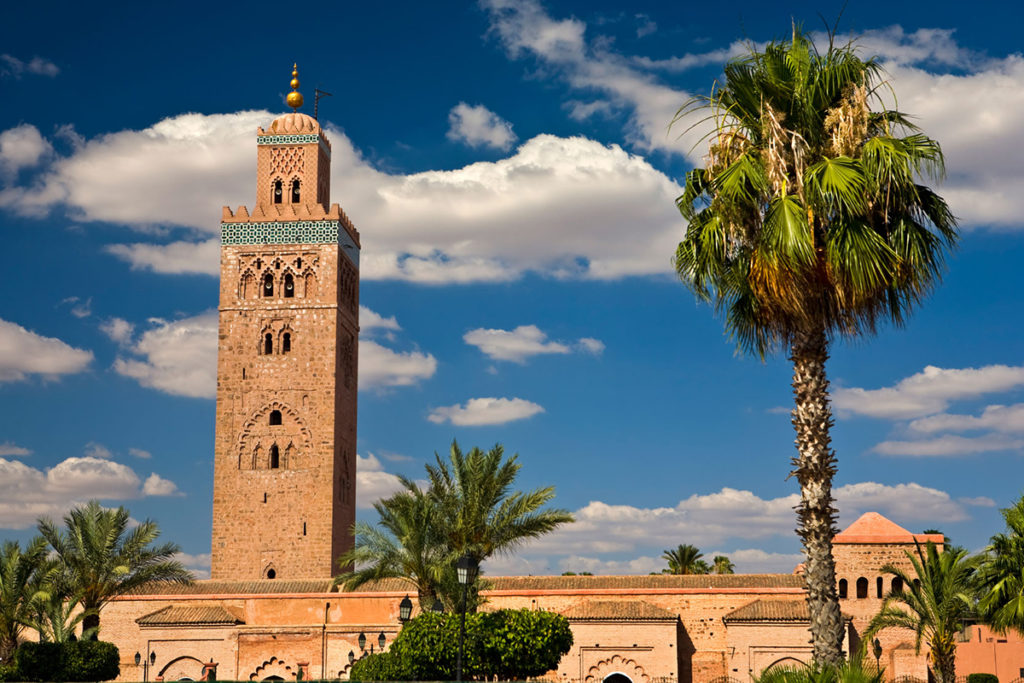
The Koutoubia Mosque, a testament to Marrakesh’s rich Islamic heritage, is one of the city’s most renowned landmarks. Its magnificent minaret, a masterpiece of Moorish ornamentation, has graced the skyline since the 12th century.
In this article, we will delve into the mosque’s history, explore its architectural marvels, uncover its cultural significance, and offer practical information to aid visitors in their exploration.
History and Construction:
The Koutoubia Mosque was constructed during the Almohad dynasty’s reign in the 12th century. The mosque was built on the site of an earlier mosque and took over twenty-five years to complete.
Over the centuries, the mosque underwent several renovations and additions, with the most significant occurring in the 16th century when Saadian sultan Ahmad al-Mansur commissioned an expansion of the prayer hall.
Architecture and Design:
The Koutoubia Mosque minaret is a prototype for other famous minarets in Spain and Morocco.
Its square design is unique and is an Amazigh trademark. The mosque’s exterior is adorned with intricate stucco carvings and features a large courtyard with fountains.
Inside the mosque, the prayer hall is a spacious and peaceful place for worship, with a beautifully decorated mihrab.
Cultural Significance: The Koutoubia Mosque has played an essential role in Islamic culture, serving as a place of worship for centuries.
It also holds significant historical and cultural importance in the region, as it has influenced Moroccan art and architecture.
The name “Koutoubia” comes from the Arabic word for bookseller, reflecting the mosque’s proximity to the city’s old booksellers’ market.
Ruins of the Prayer Hall: The original prayer hall at the Koutoubia Mosque collapsed during the 1755 Lisbon earthquake, leaving only ruins behind.
However, the remaining features of the hall, such as the columns and arches, serve as a memorial to the mosque’s past.
Visiting the Koutoubia Mosque:
Visitors can observe the mosque’s exterior from the large courtyard, but non-Muslims are not permitted to enter the mosque or minaret.
Friday prayers offer a unique opportunity to observe the mosque in use, but visitors should dress modestly and respectfully.
Photography Tips
Golden Hour Magic: Capture the majestic Koutoubia Mosque during the golden hour at sunrise or sunset for the best photos.
The best time to visit the mosque is during the early morning or late afternoon when the sun casts a beautiful glow on the minaret.
Where to Stay and Eat near Koutoubia Mosque:
There are many budget hotels located near the Marrakesh medina walls, offering a convenient location for visitors to explore the city.
For those looking for a more luxurious experience, upmarket riads off Rue Riad Zitoun El Jedid offer an authentic Moroccan stay.
Nearby Pâtisserie des Princes is a perfect spot for a sweet treat after a day of sightseeing.
Conclusion:
The Koutoubia Mosque is a significant landmark in Marrakesh, representing the city’s Islamic heritage and cultural significance.
The mosque’s enduring legacy has influenced Moroccan art and architecture, and its minaret has served as a prototype for other famous minarets in Spain and Morocco.
While non-Muslims cannot enter the mosque or minaret, visitors can appreciate its beauty from the outside and learn about its history and cultural significance.
Frequently Asked Questions
The Koutoubia Mosque is the most significant monument in Marrakesh due to its central location in Jemaa el Fna Square, its rich history spanning 900 years, and its iconic 77-meter-high minaret.
Entry to the mosque is restricted to individuals of the Muslim faith. Non-Muslim can explore the exterior, admiring its impressive walls
The Koutoubia Mosque’s prayer hall has the capacity to house up to 25,000 worshippers.
Yes, near the mosque’s Kasbah or Jewish Quarter side, you’ll find the Koutoubia Gardens.
These gardens feature various plant species, including palms and fruit trees, and are a popular spot for relaxation and mingling with locals and tourists.